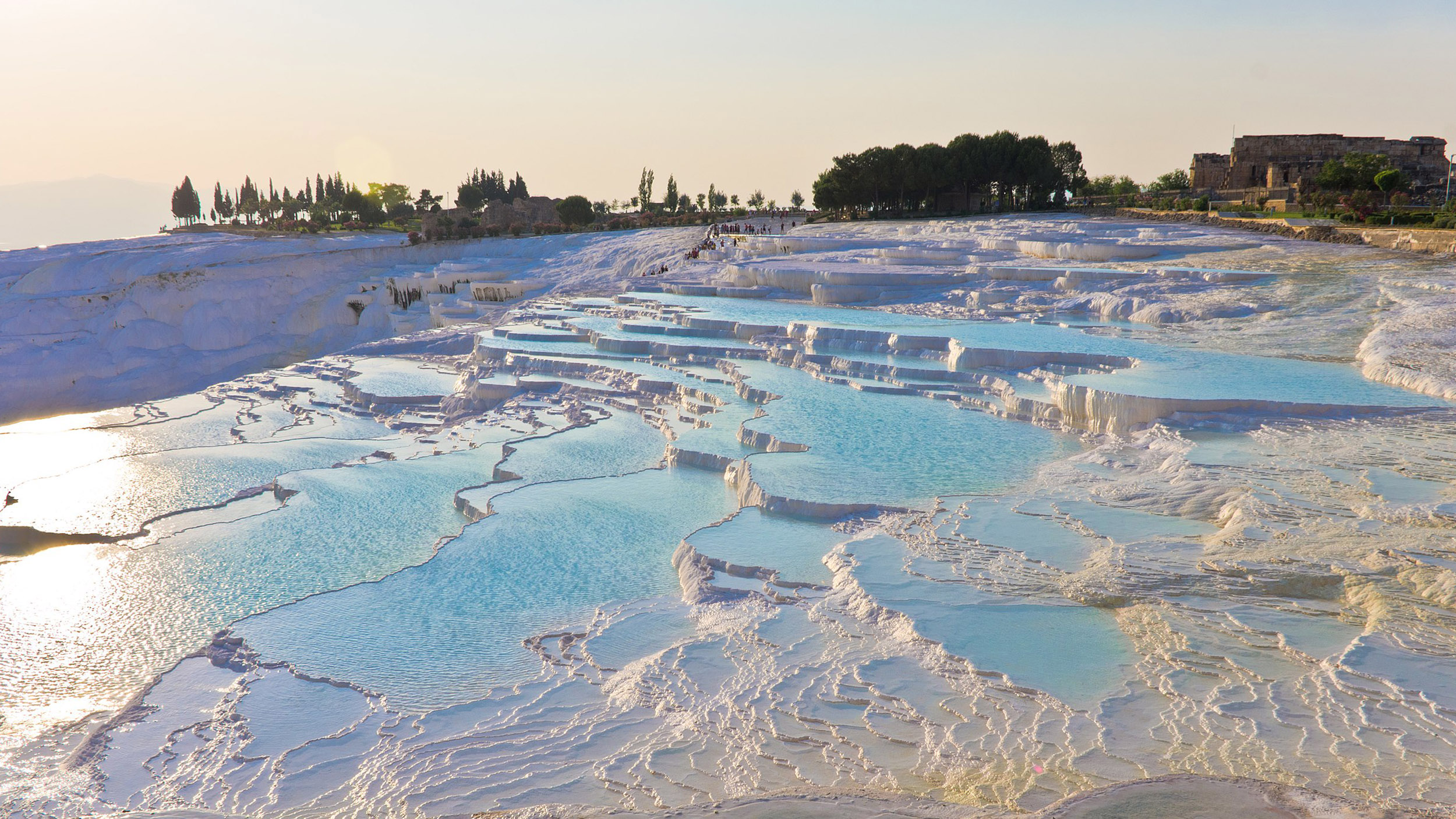So far as quality of life went in the Classical world, it was pretty great to be a Roman and not-so-great to be their enemy. But say what you will about the Roman tendency to push the boundaries of their empire ever outward — at least they left some truly spectacular soaking pools behind.
One of the most striking examples is the Pamukkale Water Terraces, located in the Menderes River Valley in Turkey. Pamukkale is a Turkish word roughly meaning “cotton castle.” When you see the photos, you’ll know exactly why the term applies so well.
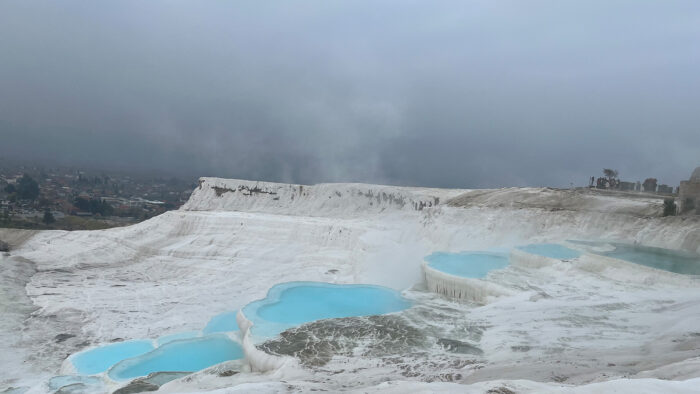
Photo: Wikimedia Commons
Right place, right minerals
The Pamukkale Water Terraces cover an area of roughly 2,100 square meters. Seventeen hot springs bubble up at temperatures between 35° and 100°C, enhancing the shimmery, unforgettable natural formation.
The steaming waters are super-rich in calcium carbonate. When the hot, calcium-heavy liquid reaches the surface, it de-gasses carbon dioxide, eventually leaving behind a crust of calcium carbonate ledges. Geologists call such formations a travertine terrace.
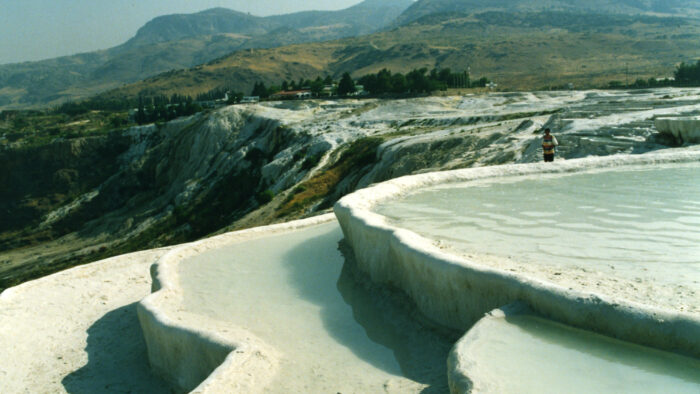
The Pamukkale Water Terraces. Photo: Wikimedia Commons
Hot springs exist the world over, from Japan to Scandinavia. But few spots match the Pamukkale Water Terraces for geological beauty. It takes a rare combination of factors to create a travertine terrace — hot enough water, springs that bubble up from a slope, and the perfect combination of minerals in the water. Mammoth Hot Springs in Yellowstone National Park is another example.
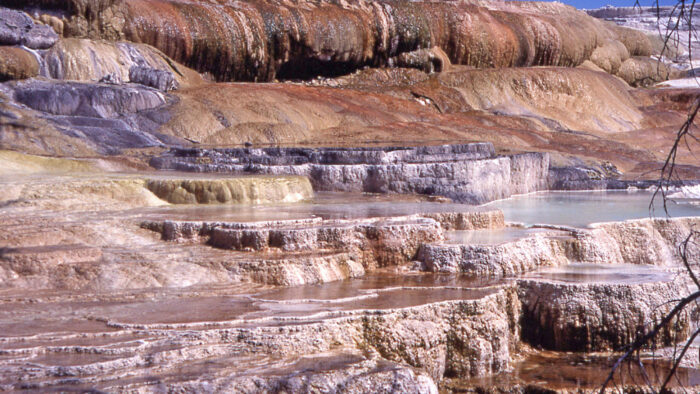
Mammoth Hot Springs at Yellowstone National Park in Wyoming is another example of a travertine terrace. Photo: Wikimedia Commons
Hot but not too hot
But the water at Mammoth Hot Springs is dangerously hot, and sulfurous to boot. It wouldn’t make a pleasing place to take a dip. Travertine terraces that throw in a precious fourth factor — friendliness towards the perpetually aching human body — are even rarer.
Terme di Saturnia in Italy is one such spot. For centuries, the tiny town of 300 has drawn visitors from around the world to its scenic pools.
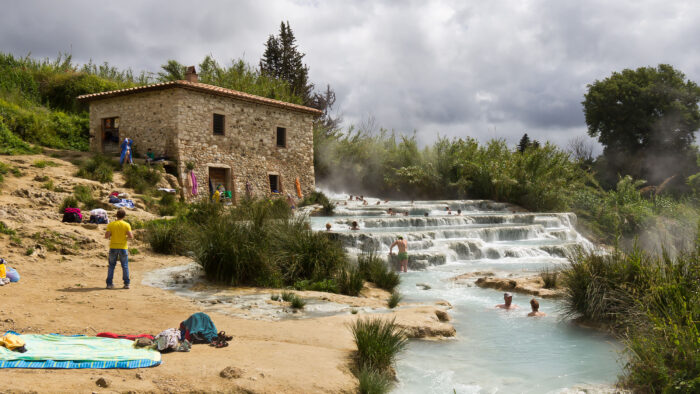
Terme di Saturnia in Italy, another travertine terrace with a long history of human enjoyment. Photo: Wikimedia Commons
In that regard, Terme di Saturnia shares a lineage with the Pamukkale Water Terraces. As a Mediterranean country located at the crossroads of Europe and Asia, Turkey has been continually populated since the Late Paleolithic. It’s likely that our Stone Age ancestors made liberal use of the Pamukkale Water Terraces to soak their tired muscles, as you would too if your life consisted primarily of either running from or chasing dangerous animals.
Nearly 3,000 years later, the combination of beautiful scenery and relaxing hot pools still attracts us. But as we’ll see, such attraction comes at a cost to the landscape.
Early temple
The water terraces lie within the historical kingdom of Phrygia, which, according to Greek mythology, produced the legendary kings Midas and Gordias (of the famous knot). Modern archaeological digs indicate that the Phyrgians first built a temple there sometime in the 7th century BC, though likely people also lived there during the earlier Iron Age.
The original temple was a tribute to a Phrygian mother goddess named Cybele. Local spiritual traditions around Cybele purported that only her eunuch priests could survive inhalation of the gases emitted from the springs and surrounding caves.
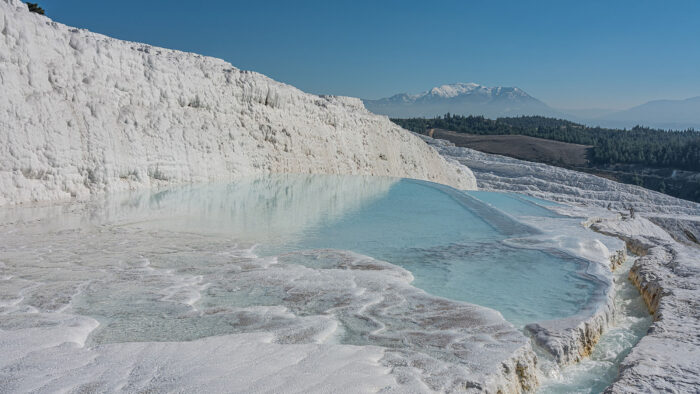
The natural beauty of the Pamukkale Water Terraces inspired centuries of religious and healing practices. Photo: Wikimedia Commons
During the Hellenistic period — a time when Greek culture spread across the Near East, thanks to the efforts of Alexander the Great — the region was colonized by the Seleucid Empire, a nation of Western Asian Greeks founded by a former general after Alexander’s untimely death.
The Selecuids built the city of Hierapolis sometime between 281 and 261 BC, using the site of the original temple as a starting place. (Hierapolis means “holy city.”) After the city’s founding, Cybele worship was absorbed into newcomers’ religion, and the springs, terraces, and temple became associated with Hades and his consort Persephone. Greek doctors swiftly incorporated the waters into their healing practices, and people traveled from all over the ancient world to visit the site.
The Romans step in
But as always, when discussing hot springs and antiquity, we can’t forget the Romans. The ever-expanding society took control of the region in 133 BC. A series of powerful earthquakes leveled Hierapolis during the reins of Emperors Tiberius and Nero. But the Romans never saw a pile of Hellenistic stones they failed to rebuild in their own image.
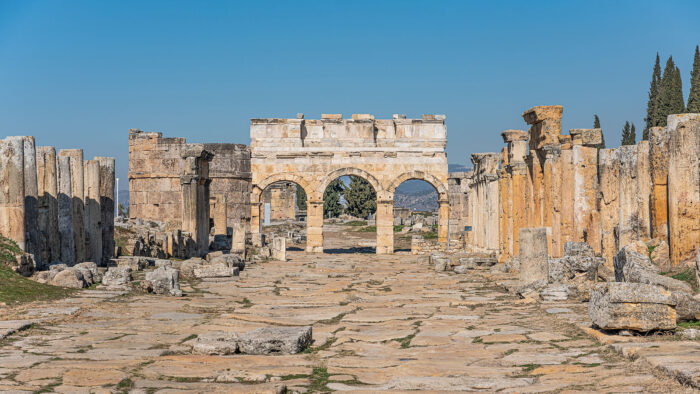
The ruins of the main street and gate at Hierapolis. Early archaeologists began to excavate the city in the late 1800s after nearly 400 years of abandonment. Photo: Wikimedia Commons
The Romans swiftly got to work building Roman-style baths, amphitheaters, gymnasiums, fountains, colonnaded streets, and other examples of their famous infrastructure. With the Pamukkale Water Terraces as a stunning focal point, Hierapolis became a thriving artistic and cultural center on the eastern fringes of the late Republic/early Empire.
Many luminaries of Roman society came to call Hierapolis home, including the famed Stoic slave-turned-philosopher Epectitus.
Rise and fall and rise again
The apostle Paul founded a church in Hierapolis during his ministry. As the influence of the early church spread over the centuries, Christian traditions gradually replaced the Hades-centered worship that had, in turn, replaced the mother goddess Cybele.
By 500 AD, Hierapolis and the Pamukkale Water Terraces were an important Christian site within the Byzantine Empire. But the coming turbulent centuries were not kind to the region. Persians sacked the city in the 7th century, and another earthquake destroyed what the Persians left behind. Inhabitants rebuilt again, only to see the city sacked by European crusaders in 1190.

The Pamukkale Water Terraces from above. Photo: Wikimedia Commons
In 1354, a final earthquake completed the job. The last remnants of the ancient city toppled over, and time and elements covered the once-grand walls with sediment and stone.
Luckily, the same geologic activity that created the Pamukkale Water Terraces managed to spare the natural feature even as it toppled the structures mankind had built. As archaeologists in the late 1880s began excavating Hierapolis, contemporary travelers and tourists also rediscovered the Water Terraces. Perhaps inevitably, hotels sprang up, and foot traffic over the decades did the damage that centuries of earthquakes had been unable to do.
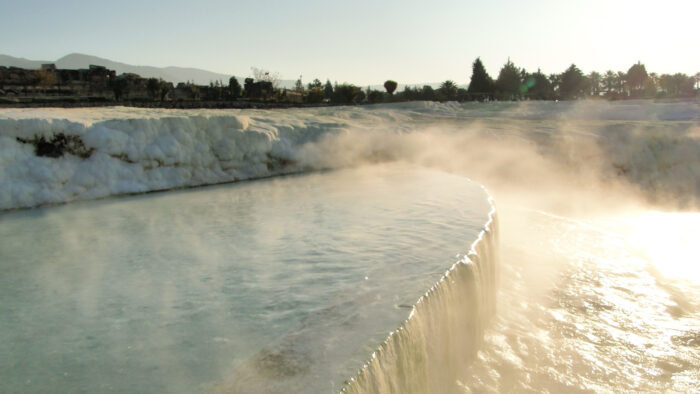
Photo: Wikimedia Commons
Luckily, Hierapolis-Pamukkale became a UNESCO World Heritage Site in 1988. Most of the hotels were torn down, and traffic in and around the Pamukkale Water Terraces was severely limited. While still a major tourist attraction today, the Terraces appear on track for preservation into the coming centuries and — hopefully — beyond.
